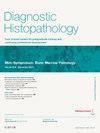垂体神经内分泌肿瘤的最新分类和诊断方法
引用次数: 0
摘要
垂体前叶肿瘤约占颅内肿瘤的20%,是整个神经内分泌系统中最常见的肿瘤,在垂体专科中心的诊断工作量中占有相当大的比例。第五版《世界卫生组织内分泌和神经内分泌肿瘤分类》(ENDO5)对腺上皮细胞瘤的分类进行了修改,包括垂体神经内分泌肿瘤(PitNET)的命名、引入恶性肿瘤的ICD-O代码、用 "转移性PitNET "一词取代垂体癌,以及进一步强调系限制转录因子在诊断中的应用。ENDO5并未提及在PitNET分子图谱分析方面取得的任何进展,也未提出任何识别具有侵袭潜力的PitNET的建议。本综述旨在评估ENDO5中引入的变化,并为解释PitNETs的分类及其诊断方法提供实用建议。本文章由计算机程序翻译,如有差异,请以英文原文为准。
Update on the classification and diagnostic approach of pituitary neuroendocrine tumours
Tumours of the anterior pituitary account for around 20% of intracranial neoplasms and are the most common tumours of the entire neuroendocrine system, representing a sizeable proportion of the diagnostic workload for specialist pituitary centres. The 5th edition WHO Classification of Endocrine and Neuroendocrine Tumours (ENDO5) introduced changes to the classification of adenohypophyseal cell tumours including the nomenclature of pituitary neuroendocrine tumours (PitNET), the introduction of an ICD-O code for malignancy, and the term ‘metastatic PitNET’ to replace pituitary carcinoma, and further emphasis in the diagnostic use of lineage restricted transcription factors. ENDO5 did not mention any progress in the molecular profiling of PitNETs or any proposal to identify PitNETs with aggressive potential. This review aims to appraise the changes introduced in ENDO5 and provide practical suggestions to interpret the classification of PitNETs and to their diagnostic approach.
求助全文
通过发布文献求助,成功后即可免费获取论文全文。
去求助
来源期刊

Diagnostic Histopathology
Medicine-Pathology and Forensic Medicine
CiteScore
1.30
自引率
0.00%
发文量
64
期刊介绍:
This monthly review journal aims to provide the practising diagnostic pathologist and trainee pathologist with up-to-date reviews on histopathology and cytology and related technical advances. Each issue contains invited articles on a variety of topics from experts in the field and includes a mini-symposium exploring one subject in greater depth. Articles consist of system-based, disease-based reviews and advances in technology. They update the readers on day-to-day diagnostic work and keep them informed of important new developments. An additional feature is the short section devoted to hypotheses; these have been refereed. There is also a correspondence section.
 求助内容:
求助内容: 应助结果提醒方式:
应助结果提醒方式:


